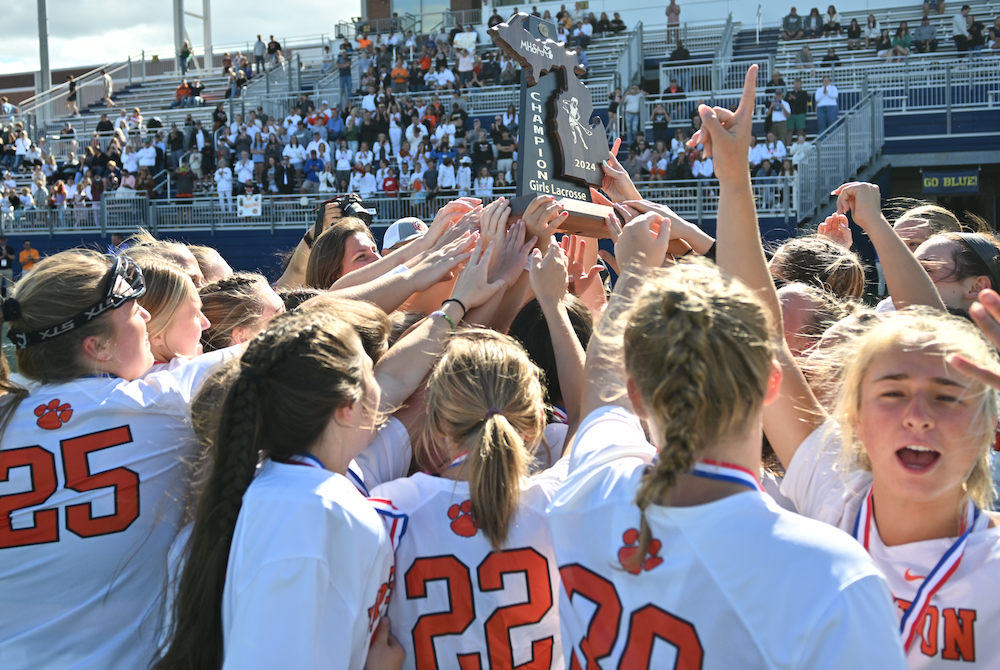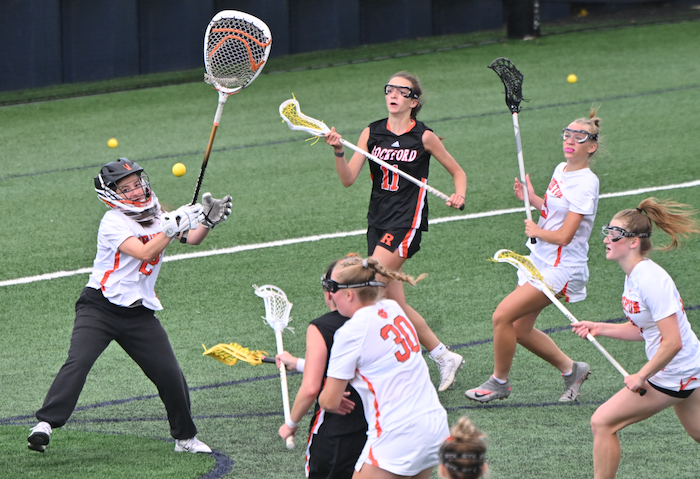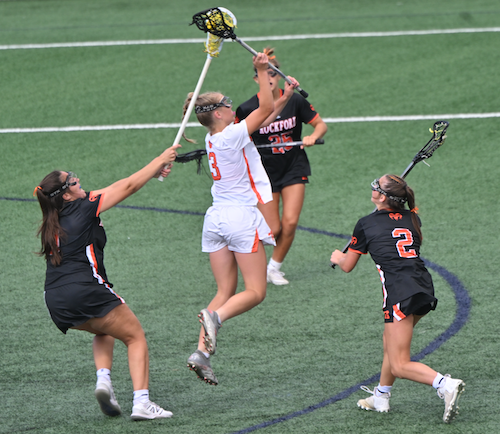
Casting Lines for Future Tournaments
August 12, 2016
By Jack Roberts
MHSAA Executive Director
The MHSAA is best known to the public for the tournaments it conducts to conclude the fall, winter and spring seasons each school year.
These tournaments, the first and largest program of the MHSAA, have survived the Vietnam War, the Korean conflict and two World Wars. They have survived the technology bubble, the housing collapse, the energy crisis and the Great Depression.
MHSAA tournaments existed at the dawn of aviation and at the time of our nation’s lunar landing. Popes, presidents and governors have changed and changed again and again, and MHSAA tournaments roll on year after year.
But the sense of tradition and permanence and inevitability of MHSAA tournaments doesn’t dissuade us from asking questions about our tournaments, even some of the most basic questions. Here are two.
Question #1
I have long been and will always be an advocate for a Ryder Cup format for the MHSAA Golf Finals, and a team tennis approach to the MHSAA Tennis Finals; but 90 years of tradition is hard to overcome. Might this be a more exciting format? Could it be co-ed? Could it reverse the decline in boys tennis participation, and increase girls golf participation? Wouldn’t it be fun to try?
Periodically, the International Olympic Committee requires each of the designated Olympic sports to defend its status, to state its case why the sport should remain a part of the Olympic program. Then, after a series or votes that retain one sport at a time, the IOC drops the sport that makes the weakest case. It does so to make room for one of the previously unlisted sports that makes the best case for inclusion.
This would appear to keep the existing Olympic sports on their toes, and to keep the Olympic movement fresh and reflective of modern trends in sports.
While I would not enjoy the controversy, I can see the potential for some positive results if the MHSAA were to invoke the same policy for determining the 14 tournaments it will provide for girls and the 14 for boys.
This might cause us to consider more deeply what a high school sport should look like, or at least what an MHSAA tournament sport should stand for.
On the one hand, we might be inclined to drop tournaments for those sports that involve mostly non-faculty coaches and non-school venues, or require cooperative programs to generate enough participants to support a team, or resort almost entirely to non-school funding, or cater to individuals more than teams.
Or perhaps this process would cause policymakers to forget traditional thinking and ask: “In this day and age, should we shake off traditional notions of sport and consider more where modern kids are coming from?” That might mean fewer team sports and more individual sports, more “extreme” sports like snowboarding and skateboarding, and more lifetime sports, meaning not just golf and tennis and running sports, but also fishing and even shooting sports.
Currently, MHSAA policy states that the MHSAA will consider sponsorship of a tournament series for any sport which 64 member schools conduct on an interscholastic basis as a result of action by the governing boards of those schools.
Should the only question be how many schools sponsor a sport, or must an activity also have certain qualities and/or avoid certain “defects?” What should an MHSAA tournament sport look like and stand for?
Question #2
Bristling from criticism that his association is a money-grabbing exploiter of children, my counterpart in another state said, “If we were running our programs just to make money, we would do very many things very differently.” I knew exactly what he meant.
Because we care about the health and welfare of students, because we mean what we say that the athletic program needs to maximize the ways it enhances the school experience while minimizing academic conflicts, and because we try to model our claim that no sport is a minor sport when it comes to its potential to teach young people life lessons, we operate our programs in ways that make promoters, marketers and business entrepreneurs laugh, cry or cringe.
If money were the only object, we would seed and select sites to assure the teams that attracted the most spectators had the best chance to advance in our tournaments, regardless of the travel for any team or its fan base. If money were the only object, we would never schedule two tournaments to overlap and compete for public attention, much less tolerate three or four overlapping events. If money were the only object, we would allow signage like NASCAR events and promotions like minor league baseball games.
Those approaches to event sponsorship may not be all wrong; they’re just not all right for us. And we will live with the consequences of our belief system.
During a typical school year, more than 20 percent of the MHSAA’s 2,097 District, Regional and Final tournaments lose money. Not a single site in golf, skiing or tennis makes a single penny. In no sport did every District, Regional and Final site have revenue in excess of direct expenses.
In fact, in only three sports – boys and girls basketball and football – is revenue so much greater than direct expenses overall that it helps to pay for all the other tournaments in which the MHSAA invests.
That’s right: invests. When we present our budget to our board, we talk about the MHSAA’s investment in providing tournament opportunities in all those sports and all those places that cannot sustain the cost of those events on their own. How much is this investment worth to students, schools and society?
These two are core questions that require our focus far in advance of talk about scheduling, site selection, seeding and the myriad matters that too often hijack our time and attention.

Full-Strength Brighton Avenges Loss, Extends Championship Streak to 3-Peat
By
Jeff Bleiler
Special for MHSAA.com
June 7, 2024
ANN ARBOR — The Brighton High School girls lacrosse team was not at full strength when it faced — and lost to — Rockford earlier this season.
Neither Cecelia Mainhardt nor Ella Toth played in that game.
On Friday, the pair of all-staters introduced themselves to the Rams and carried Brighton to its third straight Division 1 Finals championship at the University of Michigan Lacrosse Stadium.
Mainhardt scored three goals and assisted on another, and Toth added a goal of her own to help Brighton to a 7-4 victory in the first Finals game contested at the U-M venue.
“It feels absolutely incredible. It’s hard to put into words,” said Brighton coach Ashton Peters, who capped her sixth season by capturing Brighton’s fourth lacrosse championship. “To do it in this setting and this stadium, it was an absolute honor.
“It’s school history for us. I don’t know that there’s a team at this school that’s had three state titles on the girls side, so we’re very happy.”
In a defensive game that was somewhat reminiscent of Rockford’s 10-5 regular-season victory, Brighton (19-5) made the most of its opportunities and held the Rams to just four first-half shots.
Toth opened the scoring with a goal at the 5:05 mark of the first quarter after the Bulldogs controlled the ball for the first four minutes of the period. Brooke Gordon tied the score for Rockford with a goal at the 2:22 mark after two straight shots clanged off the crossbar.
 The second period was all Brighton as Mainhardt sandwiched two goals between a Sophia Heady score that Mainhardt assisted on to give the Bulldogs a 4-1 halftime advantage. Mainhardt and Heady scored 19 seconds apart, and Mainhardt’s second goal came with just 1.8 seconds left on the clock.
The second period was all Brighton as Mainhardt sandwiched two goals between a Sophia Heady score that Mainhardt assisted on to give the Bulldogs a 4-1 halftime advantage. Mainhardt and Heady scored 19 seconds apart, and Mainhardt’s second goal came with just 1.8 seconds left on the clock.
Rockford was far more aggressive during the third quarter, scoring twice on goals by Ashley Palmer and Aubree Frazier, but Georgia Gill’s goal kept Brighton ahead 5-3 entering the final quarter.
Mainhardt scored less than two minutes into the fourth, and Gill added another tally just over two minutes later before Frazier’s second goal of the game closed out the scoring with 3:36 to play just as a penalty to Mainhardt had expired. Brighton goalie Gabi Buckenberger came up with several clutch saves throughout the game to preserve the victory.
“It’s so amazing, it’s like nothing I’ve ever felt before,” Mainhardt said. “Ever since we won my sophomore year, it’s a feeling I’ll never forget.”
Mainhardt missed the first game against Rockford with a concussion, and her return to the lineup in the Final, along with Toth’s, was a huge addition for the Bulldogs.
“We were like, this is a bummer because we really want to beat Rockford, but we also knew not having them in that game would put us in a spot where Rockford didn’t know them, which would be an advantage to us because of the talent those two bring to our team,” Peters said.
“The biggest thing for us today was we knew some of the things they did, but they didn’t know everything we could do.”
Rockford, which finished the season with a 13-8 record, was denied a 10th Division 1 title. Coach Mark Neumen said nerves might have played a part in the Rams’ second-lowest-scoring output of the season.
 “A big venue like Michigan, I think the girls were really having a hard time getting going, getting the adrenaline,” Neumen said. “They were really not picking their spots like they normally do. They were shooting to shoot instead of getting those shots off like they normally do. That was the struggle we were having. We were getting good looks but just not finishing.”
“A big venue like Michigan, I think the girls were really having a hard time getting going, getting the adrenaline,” Neumen said. “They were really not picking their spots like they normally do. They were shooting to shoot instead of getting those shots off like they normally do. That was the struggle we were having. We were getting good looks but just not finishing.”
Neumen was pleased with his defense, which held Brighton to just seven goals after the Bulldogs had outscored their four postseason opponents by a combined 63-32.
“Holding them to seven goals was probably better than I expected,” he said.
Brighton loses just four seniors, including Mainhardt, who will play at Grand Valley State University next year. Coincidentally, the team had four seniors last year, which Peters admitted she expected to be a rebuilding year.
But losing Mainhardt will be difficult, Peters said.
“She is an incredible player, all-around as an athlete, as a person, everything,” Peters said. “She’s exactly what a coach wants. And in the moments that we need her most, she steps up and she does everything that we need, and today that’s exactly what you saw. She’s going to be greatly missed next year.”
Calling her team “like a family,” Mainhardt said while she will miss playing with them, she will treasure the memories.
“This program has made me one of the best players I could have possibly been, especially the youth program,” she said. “The youth program is incredible, and I just thank my coaches and thank my teammates every day because they’re awesome.”
PHOTOS (Top) Brighton raises its championship trophy Friday evening at U-M Lacrosse Stadium. (Middle) Bulldogs goalie Gabi Buckenberger (29) defends as Rockford makes a run at her goal. (Below) Brighton's Kelly McKaig (3) attempts to gain possession while surrounded by Rams.

